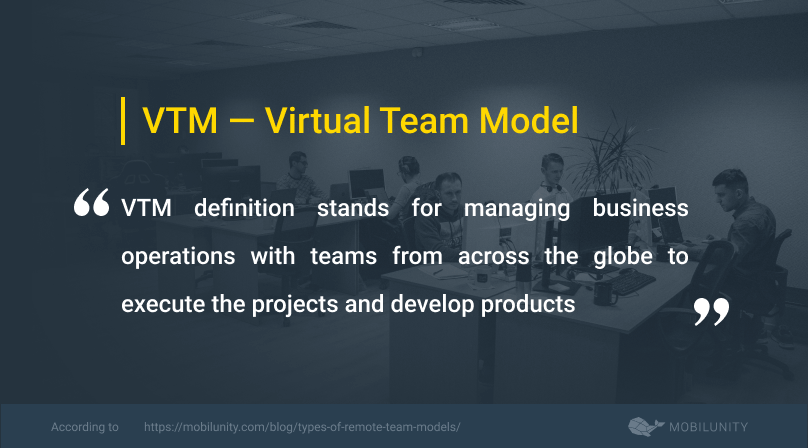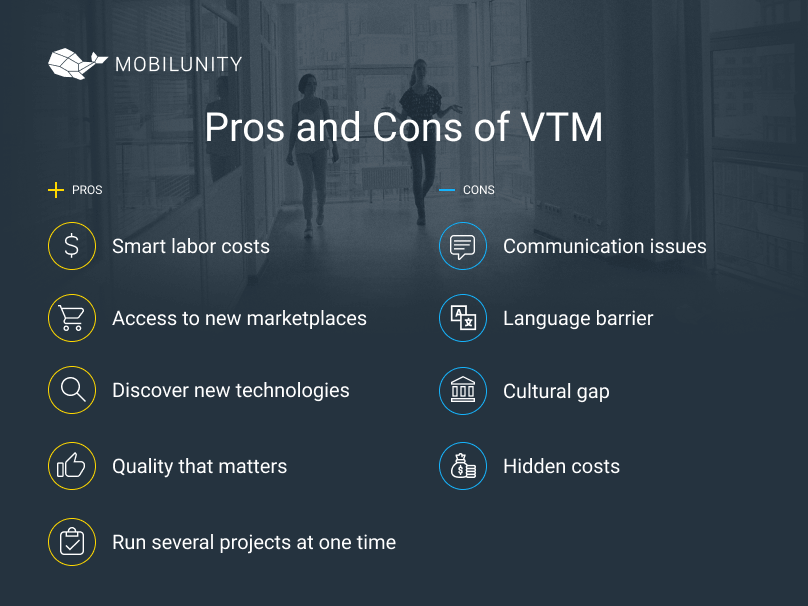VTM (Virtual Team Model)
What is VTM? The virtual team model definition stands for managing business operations with teams from across the globe to execute the projects and develop products. Geographically dispersed teams can perform separate projects or create a brand new product for a company’s business goals [1].
When VTM Originated?
VTM definition appeared at the beginning of the 21st century when the PC industry started gaining momentum and developed the Information and Communication Technology sector, companies started looking for ways to differentiate from competitors and obtain a distinctive advantage to their products through hiring remote teams. However, even before these times, in the 80th, the United States found considerable benefits of hiring remote teams from India as they offered low labor costs [2]. With time, the ICT industry started to grow its potential in developing countries which made VTM demanding.
These days, according to the SHRM report, in 2019, the tendency of having dispersed teams worldwide has increased at 69% while hiring freelancers showed only 35% of the increase [3]. So why VTM?
What Is a Virtual Team Model and How Do VTM Services Work?
VTM meaning stands for hiring remote teams via offshoring or nearshore outsourcing. The first option presupposes a client to delegate the project execution to the team without having full control at all stages of development. Nearshoring, on the other hand, allows you to make changes, implementations, and deal with work-related obstacles throughout the whole development process.
Offshoring might be useful for those clients who do not possess a rich technical background, as the vendor and team in such a case will take care of everything. Nearshoring requires a client to be technology-aware to handle the technical side of the project. However, some VTM companies may offer to hire a Chief Technology Officer to assist in these matters.
Choose Your Type of Virtual Teams. What Are These?
Depending on your business goals, project’s peculiarities, and personal preferences, you can define the type of VT to guarantee long-term and smooth cooperation [4].
If you need expert assistance for your internal project, cross-functional specialists are here to help. Usually, network teams are hired for a short period of time, and when their role is completed, they are no longer employed by the company. The benefit of such a team is that you can scale it up or down whenever needed, but acting in accordance with the contract.
Parallel Teams
Another useful type of VT for a short period of time, when you need specialists to assist in a matter, supervision, or receive some recommendations. Quite often parallel teams are hired by multinational companies when a global viewpoint is vital.
Project Development Teams
One of the first and traditional types of VT introduced in the early 90s. From its name, one can identify that these teams are preferably hired to work on a particular project or develop a product. Mostly, these teams remain in the same size from the beginning to the product release.
Work, Production or Functional Teams
A kind of a hybrid virtual team model where each member of the team is assigned a particular set of responsibilities that are hardly ever interconnected with other team members. Each of the employees executes a part of the process, that is after composed in one huge product.
Services Teams
Such teams are especially beneficial for those businesses that require 24/7 customer support in all time zones, such as mobile operating systems or banking applications.
Offshore ISD Teams
One of the common types of VR popular among large enterprises, SMEs, and startups. It allows you to integrate both collocated and distributed teams, establish proper communication with the ISD team, and control the stages of project development personally.
Hiring Virtual Teams: Key Pros and Cons
No matter which model of virtual teams you prefer, this approach of employment gives you the following advantages [5]:
- Smart labor costs. Offshoring and nearshore outsourcing offers considerably lower salary rates than your domestic ones.
- Access to new marketplaces. Promoting a product, gaining recognition, establishing a competitive stand is possible with invading the new market.
- Discover new technologies. The world of IT is overwhelmed with talented people who are striving to commit to your product by proactively implementing innovations.
- Quality that matters. Any product company is highly concerned about the quality of services; dedicated software development teams are the ones whose primary motive is to deliver high-quality products.
- Run several projects simultaneously. You can hire several teams in different parts of the world to manage 2-3 projects at the same time. By doing so, you (1) increase overall efficiency, (2) focus on the core operations.
Every coin has two sides, so before jumping into the evolving approach of hiring dispersed teams, here are some limitations to consider.
- Communication issues. You may face the issues in communication if initially this aspect wasn’t set up clearly. Lack of the proper feedback system, scheduled meetings and syncs lead to miscommunication.
- Language barrier. As you speak different languages, make sure your team possesses at least an intermediate level of English to be able to avoid inaccuracies in understanding each other.
- Cultural gap. Different cultures might affect the way troublesome situations are solved. You can also face the opposite business standpoints so choosing the culture that precisely fits your stand might prevent such occurrence.
- Hidden costs. If you have no direct control of your project, meaning that you don’t manage your team by yourself, you may face additional paychecks as the vendor decided to hire another QA engineer in the middle of the project execution.
Success Stories of VTM Users
While some companies only discover what is a VTM, other organizations are reaping the benefits of a global virtual team model. Companies like GitHub, GitLab, inVision, TimeDoctor have their teams working from around the world. Proven quality, excellent communication, dedication, and loyalty have leveled up these organizations’ efficiency and productivity. According to the Economist Intelligence Unit report, virtual working is a common practice for 49% of the companies participating in the survey. They claimed that virtual working does not affect overall employee productivity and efficiency, making them as successful as with collocated teams [6].
See Also
References
- https://www.academia.edu/11676651/Global_Delivery_Models_The_Role_of_Talent_Speed_and_Time_Zones_in_the_Global_Outsourcing_Industry
- https://blog.dce.harvard.edu/professional-development/challenges-managing-virtual-teams-and-how-overcome-them
- https://www.managementstudyguide.com/types-of-virtual-teams.htm
- https://www.managementstudyguide.com/virtual-teams-advantages-and-disadvantages.htm
- http://graphics.eiu.com/upload/eb/NEC_Managing_virtual_teams_WEB.pdf
















